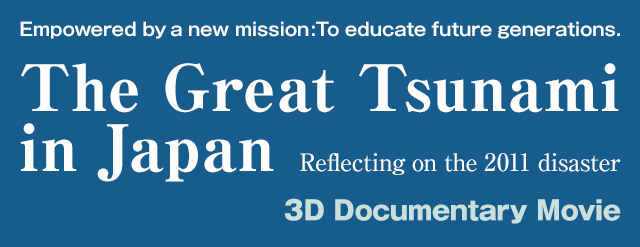Message
Atsunori Kawamura, Director
I once explored how the five-story pagoda in the Horyuji temple had survived repeated natural disasters and was still standing tall one thousand years on. Skilled master builders had built the pagoda on the premise that the core structure must withstand violent shaking or partial collapse. Japan is an island nation which has been repeatedly struck by earthquakes, volcanic eruptions, typhoons and tsunami, but which also enjoys nature’s copious riches. As each natural disaster tests the turbulent balance between nature’s wrath and nature’s bounty, the Japanese people have used their accumulated experience to build a beautiful island nation that supports fulfilling, happy lifestyles.
I began making “The Great Tsunami in Japan” documentary movie because I wanted to portray pride in Japan’s ability to build a strong nation in the face of harsh natural phenomena. I wanted to give people hope. But each time we filmed these remarkable people’s stories, it was them who gave us hope. Honoring those who have passed and passing experiences down the generations is a fundamental part of Tohoku culture. I hope this movie helps you understand and respect Japanese people whose identity is deeply rooted in land situated near often treacherous seas.
Michihiro Chikata,
Executive Producer and Director of Photography
We began filming this 3D record of specific areas in the Tohoku disaster zone directly after the 2011 earthquake and tsunami hit. At first, we were paralyzed by the expansive ravages of the tsunami, and the deafening silence in areas rudely stripped of the bustle of everyday life. We weren’t sure we would be able to fulfill our goal of portraying this horrifyingly stark landscape on film.
Today, we have created the world’s only 3D film of a disaster-struck zone, filmed consistently from fixed locations to observe changing dynamics over a period of more than three years. Each time we filmed, the evidence of the 2011 disaster gradually disappeared, and then the disaster zone started to change rapidly. Heavy machinery erased towns where people had led peaceful and comfortable lives, leaving behind inhospitable, desolate stretches of land.
People can find it hard to imagine the horror of natural disaster once it has past, so it is important to leave some physical evidence that future generations can learn from. This 3D documentary account is a powerful asset because it gives the viewer a stronger sense of reality and a closer sense of involvement. I believe it will help educate people about the harsh reality of tsunami for many generations to come.
